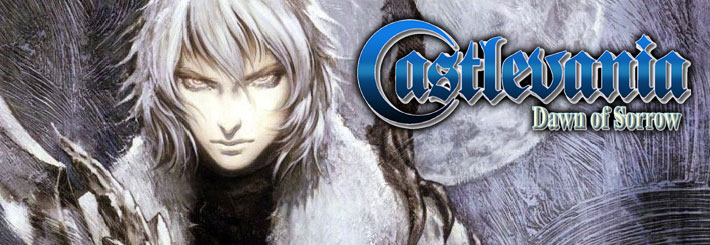Yesterday was hectic and weird, as I'm sure it was for a lot of people just coming back from a holiday break, so let me expand a little bit on Dawn of Sorrow.
First, let me say that, honestly, there isn't that much to say about the game as a whole. It does everything that its predecessor, Aria of Sorrow, had done, just a little more of it. In fact, you could say that it's classic sequelitis: the second game looks better, plays similarly, and shoehorns in unnecessary added story and play mechanics. Perhaps playing the first right after the second did this game fewer favors than it probably should have, and that's fine. There were enough years in between one game and the next that it didn't feel like a redundancy ten years ago when I first played it. But in the here and now, Dawn of Sorrow took a great game and stuffed it so full of junk food that it came out covered with pimples. There. That's a weird analogy for you.
In the continuum so far, we have Circle of the Moon, which I haven't played in a few years and have been purposely avoiding for this exercise, but I still think is a pretty good game. Harmony of Dissonance came after, and it felt too much like Iga's team shuffled in and said, "let's do that last game, but better," and it sort of wasn't. Then they hunkered down, came up with a nifty system to keep people playing during their commutes, and made Aria of Sorrow, which turned out to be a light, fun tear through the formula with a hefty grind involved. In scope of that, Dawn of Sorrow almost feels like the Harmony of Dissonance to Aria's Circle of the Moon. The team went back in, found that they wanted to do the same game over again but better, and made something that wound up feeling bland in the end.
Here's where I defend it a little, though: Dawn of Sorrow through a certain lens is kind of a cynical game. From what I've read on Wikipedia, Aria of Sorrow didn't sell up to expectations, which is a shame. A lot of work went into the design of that game, and I think it shows by the sheer craftsmanship of the characters and backgrounds and how much time and effort must have went into designing the Tactical Soul system. I get that the team --and maybe Iga specifically-- probably took a good long look at the systems specifically and said, "no, guys. This was too much to just give up on," and went to work finding ways to expand on what they had instead of tossing out the baby with the bathwater (as most of the other games had done successively). By this time, the Castlevania franchise was starting to fall into some shaky times. The 3D console games didn't set the world on fire, and the handheld releases were starting to feel more esoteric with further complex entries. The DS, only a year old when Dawn of Sorrow was released, was finding an audience with both younger crowds and a wider demographic than both its predecessors and its console competitors, so they knew that adjustments had to have been made. In that respect, what DoS does make a lot of sense.
So the character art changed. It kind of bounced off of me at the time, but it's fine now that we're ten years removed. And, again, I get it; the moody, ethereal style of the Ayami Kojima key art and box covers don't really appeal to a much younger set, and might scare off parents stumbling through a GameStop. The Tactical Soul system, even though we had already seen it before, fed into the "catch 'em all" mechanic du jour that handheld games had adopted in a post-Pokemon world. Maybe, they thought, the second time was the charm. It's possible, even, that Iga and his teams knew that producing console Castlevania games was too resource intensive, and they went back to the well with the castle and system design from Aria to keep things fast and cheap. He's even said himself over the years that he had a rep for getting his games done on time and under budget, and anyone that's followed the games industry over the past decade or so knows that reusing assets and design plans is the number one method of saving a buck.
What this all comes back around to, like every Castlevania game I've been looking at in granular detail lately, is context. Iga only produced two more games for handhelds after this, and a multiplayer cash-in game that was nothing but reused art made on the budget of whatever you probably have in your pocket right now. The series was not only falling into a rut, but its chief architect was slowly being shuffled along away from a franchise he had a hand in saving. The DS entries had the good fortune of being released on one of the most successful dedicated video game machines ever produced, but it looks like even Igarashi was starting to see the writing on the wall. I'm starting to think that the next game, Portrait of Ruin, was something of a response to all of this, but that's getting ahead of ourselves. I have to go through that with a finer-toothed comb.

No comments:
Post a Comment